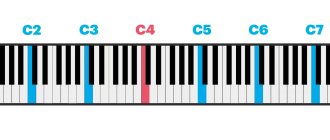How to find out the limits of your range
First, we need to understand the basic difference between the singing and audio ranges. In ordinary life, we are able to make various sounds: from a whisper to loud exclamations of joy and happiness. Such high or, on the contrary, low sounds can hardly be reproduced in singing.
The lowest and whistle register of the sound range is not involved in singing.
There are several ways to find out the limits of your vocal capabilities. This can certainly be done at home. You need to go to the piano and start chanting in accordance with the increase in the sound of the instrument (or decrease in sound). When you can no longer sing higher or lower, this is the limit of your capabilities today. IN
But there is another, more reliable and reliable way - visiting a phoniologist. He will give a full consultation and tell you whether it makes sense to develop your own capabilities, and if so, then in the direction of upper or lower case. However, you can slightly lower the sound of your own voice with the help of special exercises.
Galina Vishnevskaya
Galina Vishnevskaya is a Soviet opera singer with a soprano voice. People's Artist of the USSR, as well as a teacher and theater director.
Galina had one of the rarest combinations of voice, beauty and a wonderful, bright character. Her whole life is actions. Already from her youth, she actively worked on stage. Vishnevskaya gave people a lot of joy and incredible emotions. Her voice was recognized everywhere. Everything was perfectly combined in it.
Galina taught vocals for a very long time. She tried to put her whole soul into her students. Until the end of her life she was thanked for this.
Countertenor
A very rare voice. The highest of male operatic voices, ranging from the beginning of the small octave to (sometimes) the end of the second. The art of such singing was revived in the middle of the 20th century. And as a rule, countertenor singers perform parts written for castrati singers in the Baroque era (boys were subjected to castration surgery before their voices broke and they reached puberty, due to which their voices remained high, and they performed female parts in operas, and initially in sacred works, in choirs).
Examples of such roles can be cited both from baroque and modern opera; now the countertenor is becoming more and more popular, although it has not yet lost its exoticism, which shocks the audience. You can listen to Handel’s opera “Julius Caesar,” where the title role is written for a countertenor, or you can listen to the opera “Zurich 1916” by Christopher Butterfield, where V. I. Lenin sings as a countertenor.
Tenor
Male high singing voice. Its range is from the beginning of the minor to the beginning of the second octave. The ability to play the top notes is especially valued. If the highs are weak, then such a tenor is unlikely to become a famous soloist. Like female voices, like sopranos, tenors are divided into lyric and dramatic voices. There is also an altino tenor, which is distinguished by particularly high and sonorous notes.
There are a lot of famous and beautiful tenors. For example, Luciano Pavarotti (lyric tenor) or Placido Domingo (lyric-dramatic tenor).
A lot of parts have been written for tenors. Often the main character in Italian operas sings as a tenor. The Duke in Verdi's opera "Rigoletto", Faust in Gounod's opera of the same name, from the Russians: Lensky in "Eugene Onegin", Don Juan in Dargomyzhsky's "The Stone Guest".
The Duke's song from G. Verdi's opera “Rigoletto”. Performed by Alexander Bogdanov
Soprano
The highest female voice, usually the first and second octaves are subject to it. Moreover, the second one is often not completely. There are different sopranos: there is coloratura (bearers of such a voice easily make complex passages in the entire second octave and even reach the middle of the third), dramatic (a dense, heavy voice that easily takes notes up to the middle of the second octave), lyrical (soft, soulful, tender , silver on high notes).
Parts for soprano are among the most common. The main heroines of the operas are young girls and young women with certain life experiences. The most striking examples: the role of Tatiana from P. I. Tchaikovsky’s opera “Eugene Onegin” (lyrical), The Snow Maiden from Rimsky-Korsakov’s opera of the same name (coloratura), Lisa from Tchaikovsky’s “The Queen of Spades” (dramatic).
One of the best soprano singers in the world is Anna Netrebko.
The Snow Maiden’s aria “Walking for berries with friends” from the opera by N. A. Rimsky-Korsakov. Performed by Aida Garifullina
Voice classification
Types of singing voices can be classified according to different parameters. The first attempts to implement this were made in the 12th-13th centuries. The currently accepted characteristics of singing voices took shape in the 14th century. with the development of polyphonic choral singing. That's when they were divided by performer's gender and range. At first there were 4 main voices accompanying the music - two male and two female (bass and tenor, soprano and alto).
The increasing complexity of the repertoire led to a more detailed differentiation of voices, which first appeared in the Italian opera school. The characteristics took into account tonality, timbre, working range, tessitura (comfortable singing zone).
Ima Sumac
Ima Sumac is a singer whose voice rose to 4 octaves. A girl was born in a small village. It is worth noting that Sumak did not have any musical education at all; her voice was given to her by nature.
One day, after one of her performances, she charmed all the listeners with her voice. Success came to her quite quickly, she successfully toured in many cities. Ima herself said that she tried to imitate the sounds of nature, the singing of birds in the forest. She was able to easily move from low tones to higher ones.
Anna German
Almost every person knows Anna German . The singer had Polish roots. She could easily perform works in different languages. She has been a laureate of international festivals many times.
The girl's vocal career began for the first time in 1960. Then she found herself on the stage of the student theater, where she was invited by the director of this project.
Many composers wrote their songs for Anna. Such famous personalities were Evgeny Ptichkin, Alexandra Pakhmutova, Vladimir Shainsky and many others.
Many said that Anna has an “angelic” voice. By nature she was a soprano, but with a transparent, unusual timbre. Her manner of performing works gave the impression that there were no restrictions on voice register.
Baritone
Average male voice, range from A major octave to the middle of the first octave. This voice is strong, rich, velvety, it can be softer and more mobile, it can be close to a tenor, in which case it is called a tenor-baritone. If a baritone is stronger on low notes, but has fairly free upper notes, then it is more of a bass-baritone. Like other voices, there are also lyrical and dramatic varieties of this voice.
Perhaps the most famous baritone in the world is Dmitry Hvorostovsky , in Moscow it makes sense to listen to Vasily Ladyuk from the New Opera.
There are a lot of parts for baritone; composers often entrust them with the most important characters in the work. For example, Mozart’s Don Juan, Mizgir in The Snow Maiden, and Tchaikovsky’s Mazepa were written for baritone.
Aria of Georges Germont from the opera La Traviata by G. Verdi, performed by Vasily Ladyuk
CONTRALTO
Contralto is the lowest of the female voices and certainly the rarest . The range of the contralto is approximately from F of the small octave to F of the second, almost like that of a male countertenor.
Many of the roles written for them are old women, often unpleasant, sometimes comical. However, in the Russian repertoire we find a different state of affairs; just remember Olga from “Eugene Onegin”.
In our time, contralto as such is close to extinction. The only living person alive is the magnificent Eva Podles (Podlesch), a real contralto (born 1952). The lack of singers of this voice type means that contralto roles are often filled by mezzos .
E. Undergrowth “Non piu mesta” (fragment) from “Cinderella” by Rossini
Contraltos are divided into three broad categories:
Coloratura contralto
A light, agile voice that can reach and stay at the very top of the contralto range while maintaining a rich and powerful sound. An extremely rare voice. Rossini actually wrote his Cinderella for coloratura contralto.
Lyrical contralto
So to speak, a standard contralto, as it is. Flexible and rich voice.
Dramatic contralto
Low, dark, heavy and huge voice. Unfortunately, it is as rare a phenomenon as the coloratura contralto. Erda in The Ring of the Nibelungs is a good example of this type.
Methods and exercises for low sound
Here I will give three main areas in which you should begin to act. This is training the vocal folds, working with breathing and articulation. First things first.
Vocal fold training
The vocal fold is a mucous membrane made up of vocal cords and muscles. These muscles, like regular muscles in the body, can be trained and pumped up. And the thicker the muscles become, the lower the voice.
What you can do for this:
- Talk a lot. It doesn’t matter who is in front of you: an attentively listening colleague or an indoor cactus. Talk about how your day went, read poems, news aloud, repeat phrases after TV show hosts, etc. You can turn on the “nonsense generator” and for 10 minutes say everything that comes to mind about some subject. Even if the words are incoherent, illogical, stupid, allow yourself to say them.
- Think out loud. You need to talk silently, to yourself, but straining your vocal folds in the same way as would happen during a normal conversation. In this way, you can read books or simply think about something, saying words in your mind.
- Sing and shout. This helps warm up the ligaments and makes them more elastic and pliable. You can find audio recordings of vocalists with a low timbre and try to sing along as close to the original as possible. As for screaming, in order not to embarrass your neighbors, you can use a pillow and scream into it.
- Growl. Start growling at extremely low tones, gradually increasing the pitch to a safe, comfortable limit. Then lower your voice again and raise it again.
Breath work
I suggest several exercises:
- Stand with a straight back, take a slow breath and at the same time raise your arms, first to the sides and then up. Hold your hands and breath for a few seconds, and then sharply lean forward with a noisy exhalation, lowering your hands. Perform 2-3 approaches daily.
- The starting position is the same: standing with a straight back, hands at your sides. Lean forward, bending your back and taking a sharp, short, noisy breath. Now straighten up smoothly, allowing the air to slowly escape from your lungs. Take 10 breaths, then take a 5-minute break and return to the starting position. The number of approaches can be gradually increased.
- Take a deep yawn and try to say something as you exhale.
Breathing exercises by A. N. Strelnikova are very popular. Today it is taught by Alexandra Nikolaevna’s student, Dr. Mikhail Shchetinin. I recommend watching his video tutorial.
Here are some more tips:
- Breathe with diaphragmatic breathing. That is, with the stomach, so that the shoulders and chest remain in their places, and only the stomach moves.
- Speak English. This language is much more gentle on the vocal apparatus than Russian, so it will be easier to get used to proper breathing during a conversation.
- Speak more slowly. During fast speech, the ligaments become tense and the tone automatically becomes higher.
- Watch your posture. It is necessary that the head and back are straight. The sound directly depends on the position of the larynx.
Articulation gymnastics
This type of exercise is aimed at those organs that are involved in the formation of sounds: tongue, lips, cheeks, lower jaw.
Here are some examples of such exercises:
- Press your chin to your chest and make the “ee-and-i” sound low, gradually raising your head, but without stopping the sound.
- Close your lips tightly, pull them forward, and then stretch them into a wide smile.
- Alternately raise and lower your upper and lower lips, exposing your teeth.
- Stick out your tongue and try to “draw” different numbers or letters with it.
- Move your lower jaw back and forth, and then open your mouth as wide as possible.
- Regularly pronounce the following sounds loudly and clearly: G, K, HA, O, U, M, N. They help open the back of the throat and lower the larynx best.
You can find even more articulation exercises in a separate article.
Trust your feelings
Many professional groups are overflowing with performers whose singing voices correspond to the level of mezzo-sopranos who are able to embody their talents in other categories, and this depends on the quality of technique and level of education.
A feeling of tension in singing signals that the range has been chosen incorrectly, and such performance has a destructive effect on the ligaments. When a singer experiences a feeling of lightness, freedom, and pleasure from his own performance, this means that the performer is on the right path, and distant horizons are within his control.
Women's singing
Depending on the timbre coloring, female voices are divided into 3 main groups - soprano, mezzo-soprano, contralto. They differ in lightness, transparency, strength and richness of sound.
Singers whose range and tessitura are unusually wide become legends. One of the most famous performers is Ima Sumac from Peru. She sang soprano and contralto easily, using 5 octaves.
Soprano differences
This is the highest voice, singing the note C from the first to third octave. Such vocals are distinguished by transparent lightness, sonority, open, mobile sound, and flight. Due to the variety of performing capabilities, sopranos are divided into several varieties:
- Coloratura. The name comes from the Italian word for "over". Distinguished by the ability to perform fast and complex passages and graces, melismas, roulades. It sounds from C of the first octave to F of the third octave, and can be supplemented at the top of the range with a brilliant fourth or fifth. Such a voice easily captivates with its purity and sonority, resembling a violin or flute. It does not merge with other voices, therefore it is practically not used in choral singing, and its timbre is the basis for selecting other performers. Many wonderful roles have been written for coloratura sopranos: Violetta (La Traviata), Queen of the Night (The Magic Flute), Antonida (Ivan Susanin), Lyudmila (Ruslan and Lyudmila). Modern opera divas A. Georgiou, Y. Lezhneva, A. Patti, Evgenia Miroshnichenko sing coloratura soprano.
- Lyric coloratura. They are classified as a separate type due to their melodiousness and technical agility, which allows the voice to merge with the choir. The midrange is stronger than in a coloratura soprano. Takes the range from C first octave to E third. Among the singers, Sumi Yo and N. Dessey became famous.
- Lyrical. It sounds bright in the upper register, reaches the note E of the third octave, the timbre is soft, light, silvery. In the second octave it resembles the sounds of an oboe. G. Vishnevskaya, M. Freni, B. Nilsson, M. Caballe, A. Netrebko have lyric sopranos. The roles of Mimi (La Bohème) and Tatyana (Eugene Onegin) were written for this singing voice. Sounds good in a choir.
- Lyrical-dramatic. The rich chesty timbre allows you to perform a variety of roles: Maria (Mazeppa), Tosca in the opera of the same name by G. Puccini. Performers - M. Callas, L. Marshall, R. Tebaldi.
- Dramatic. A thick, powerful voice allows you to demonstrate emotional uplift. It is distinguished by the richness of the middle and lower registers; its owners are able to produce mezzo-soprano sounds. Perfectly distinguishable against the backdrop of orchestral accompaniment. Typical roles are Aida (“Aida”), Lisa (“Queen of Spades”). Singers - M. Gulegina, M. Callas, G. Yanovits.
Composers prepare the roles of young girls or fairy-tale creatures for those with a soprano voice.
Features of the mezzo-soprano
The working range of this female voice ranges from the note A of the small octave to the A of the second. Distinctive features are saturation in the middle registers.
The overall impression of the vocals is depth and even some heaviness of the sounds. Those with a mezzo-soprano voice can sing contralto or soprano roles. In operas they often play the roles of young people, the so-called trouser parts. Mezzo-soprano can be high (lyrical) or low (dramatic). Some experts also distinguish the coloratura mezzo-soprano.
The most famous role for mezzo-soprano of the dramatic type is Carmen from the opera of the same name by J. Bizet. Also written for this unusual voice are the roles of Siebel (Faust), Cherubino (The Marriage of Figaro), Laura (The Stone Guest). Usually these are the roles of strong, brave and strong-willed women. Among the famous performers are M. Kozhena, E. Obraztsova, T. Sinyavskaya.
Contralto sound
Contralto operates in the range from small octave E to F second. This is a low voice in women. Distinctive qualities are full, dense notes in the small octave and resonance in the middle register. The upper register is small, but the low notes sound great, bringing the female voice closer to the male tonality.
The voice is very rare; not all opera houses have performers with such vocals. Composers created roles for young men for contralto, for example, the roles of Vanya in Ivan Susanin and Orpheus in Orpheus and Eurydice. Famous female roles are Olga (“Eugene Onegin”), Marie (“The Flying Dutchman”), Lucia (“Rural Honor”). Singers with contralto voices are E. Poldesh, M. Anderson.











